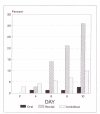Neonatal rectal colonization with Malassezia furfur
- PMID: 22451755
- PMCID: PMC3307420
- DOI: 10.1155/1992/895836
Neonatal rectal colonization with Malassezia furfur
Abstract
Malassezia furfur and Candida albicans are fungal pathogens which have been recognized with increasing frequency as agents of mortality and serious morbidity in neonatal intensive care unit patients. A longitudinal study of oral, rectal and umbilical colonization by these organisms of newborns admitted to a neonatal intensive care unit within 24 h of birth was undertaken. Of 71 infants followed for a minimum of 10 days, 24 were colonized with M furfur and 12 with C albicans during the first 10 days of life. The lower gastrointestinal tract was found to be the most common colonization site for both organisms. Statistically significant (P<0.05) inverse associations were demonstrated between gestational age and risk of colonization with either organism at any site, and between birthweight or gestational age and risk of rectal colonization with either organism. Antibiotics were associated with a relative risk colonization of 4.06 (P=0.06) with either organism at any site. It is concluded that M furfur and C albicans are common colonizing organisms in a neonatal intensive care unit setting and are most frequently harboured in the lower gastrointestinal tract. M furfur, recently implicated as a systemic pathogen in this population, has not been previously recognized as a gastrointestinal commensal organism. The relationship between colonization and invasive fungal disease, and potential roles for preventive strategies, remain to be elucidated.
Malassezia furfur et Candida albicans sont des agents pathogènes fongiques de plus en plus souvent incriminés dans la mortalité et la morbidité sérieuse qui sévissent dans les unités de soins intensifs néonatals. On a entrepris une étude longitudinale de la colonisation orale, rectale et ombilicale par ces organismes chez les nouveaux-nés admis à l’unité de soins intensifs néonatals dans les 24 heures qui suivent la naissance. De ces 71 nourrissons suivis sur un minimum de 10 jours, 24 étaient colonisés par M furfur et 12 par C albicans durant les dix premiers jours de vie. Les voies gastro-intestinales basses étaient le site le plus commun pour ces deux organismes. Des associations inverses statistiquement significatives ont été démontrées entre l’âge gestationnel et les risques de colonisation par l’un ou l’autre de ces organismes quel que soit le site, et entre le poids de naissance ou l’âge gestationnel et les risques de colonisation rectale par l’un ou l’autre des deux organismes. L’antibiothérapie était associée à un risque relatif de colonisation de 4,06 (P=0,06) par l’un ou l’autre organisme quel que soit le site. On conclut que M furfur et C albicans sont des organismes colonisateurs courants dans les unités de soins intensifs néonatals et qu’ils sont le plus souvent présents dans les voies digestives basses. M furfur, récemment impliqué en tant que pathogène systémique dans cette population, ne comptait pas, jusqu’ici, parmi les organismes commensaux gastro-intestinaux. Il faut encore élucider la relation existant entre la colonisation et l’affection fongique invasive, et les rôles potentiels des stratégies préventives.
Keywords: Malassezia furfur; Neonates.
Figures
Similar articles
-
The underestimated role of major skin commensal Malassezia furfur in the development of neonatal invasive fungal infections.Heliyon. 2024 Oct 1;10(20):e38767. doi: 10.1016/j.heliyon.2024.e38767. eCollection 2024 Oct 30. Heliyon. 2024. PMID: 39502221 Free PMC article.
-
Percutaneous central venous catheter colonization with Malassezia furfur: incidence and clinical significance.Pediatrics. 1987 Oct;80(4):535-9. Pediatrics. 1987. PMID: 3658573
-
Colonization and infection associated with Malassezia and Candida species in a neonatal unit.J Hosp Infect. 1996 Oct;34(2):123-9. doi: 10.1016/s0195-6701(96)90137-1. J Hosp Infect. 1996. PMID: 8910754
-
Human infections due to Malassezia spp.Clin Microbiol Rev. 1992 Apr;5(2):101-19. doi: 10.1128/CMR.5.2.101. Clin Microbiol Rev. 1992. PMID: 1576583 Free PMC article. Review.
-
Neonatal Malassezia furfur pustulosis.Arch Dermatol. 1996 Feb;132(2):190-3. Arch Dermatol. 1996. PMID: 8629828 Review.
Cited by
-
Oral nystatin prophylaxis to prevent systemic fungal infection in very low birth weight preterm infants: a randomized controlled trial.BMC Pediatr. 2020 Apr 17;20(1):170. doi: 10.1186/s12887-020-02074-0. BMC Pediatr. 2020. PMID: 32303210 Free PMC article. Clinical Trial.
References
-
- Powell DA, Aungst J, Snedden S, Hansen N, Brady M. Broviac catheter-related Malassezia furfur sepsis in five infants receiving intravenous fat emulsions. J Pediatr. 1984;105:987–90. - PubMed
-
- Long JG, Keyserling HL. Catheter-related infection in infants due to an unusual lipophilic yeast – Malassezia furfur. Pediatrics. 1985;76:896–900. - PubMed
-
- Azimi PH, Levernier K, Lefrak LM, et al. Malassezia furfur: A cause of occlusion of percutaneous central venous catheters in infants in the intensive care nursery. Pediatr Infect Dis J. 1988;7:100–3. - PubMed
-
- Johnson DE, Thompson TR, Green TP, Ferrieri P. Systemic candidiasis in very low-birthweight infants (<1,500 grams) Pediatrics. 1984;73:138–43. - PubMed
-
- Baley JE, Kliegman RM, Fanaroff AA. Disseminated fungal infections in very low-birthweight infants: Clinical manifestations and epidemiology. Pediatrics. 1984;73:144–52. - PubMed
LinkOut - more resources
Full Text Sources


